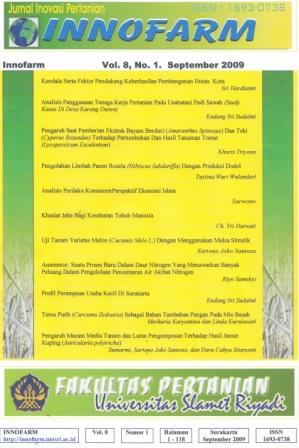TEMU PUTIH (Curcuma zedoaria) SEBAGAI BAHAN TAMBAHAN PANGAN PADA MIE BASAH
DOI:
https://doi.org/10.33061/innofarm.v8i1.230Abstract
ABSTRACT
Wet noodle is popular food in the world. Wet noodle has a sufficiently high water content, so wet noodle can’t storage a long time. Sometimes, people add a dangerous chemicals for preservative the wet noodle. But the dangerous chemicals maybe causes negative effect for we health. This watchfulness aims to look for alternative natural food addition ingredient safe for human and can the functional value increase, especially for noodle product.
White curcuma is one of spices, which became alternative food-stuff for noodle product. These plants contain compound antioksidant and other compound that can to give added value for product even can depress growth microbiology in noodle product. Besides turmeric can make coloring in the noodle.
White curcuma extract (10 mg per kg ingredient) can to depress growth mikrobia if compared with white curcuma extract 0 mg and 5 mg per kg ingredient. Mount of total microbe in noodle with 10 mg curcuma extract, showed more less than the others. Water degrees analysis result, ash degrees, degrees protein, noodle elasticity shows that more increasing extract causes the water degree extract increasing, protein, ash and elsatisitas more increase.
Analysis organoleptik result show that panelist prefers noodle without turmeric extract increasing and white tumeric. Although extract increasing until 10 mg per kg ingredient, still to liked by panelist.
Keyword : Noodle, white curcuma, total microbe
Downloads
Published
Issue
Section
License
Authors who publish this journal agree to the following terms:
- Authors retain copyright and grant the journal right of first publication with the work simultaneously licensed under a Creative Commons Attribution License that allows others to share the work with an acknowledgement of the work's authorship and initial publication in this journal.
- Authors can separately make additional contractual arrangements for non-exclusive distribution published by the journal (e.g., publish it in a book), with an acknowledgement of its initial publication in this journal.
- Authors are allowed and encouraged to send their work via online (e.g., in the institutional repositories or their website) after published by the journal.















